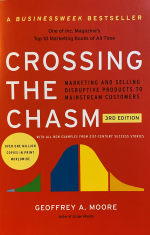
How do you change a sector?
It’s a question I’ve heard many times from ambitious and forward-looking leaders across the charity spectrum over the years. And I was asked it again this week, this time by a frustrated serial Social Entrepreneur, who had been struggling to engage a variety of large charities in the innovative on-mission solutions that her organisation could offer them.
It’s a similar question to the one I often get asked, with equal frustration, by some of my for-profit clients who work in the business-to-business space. The single biggest challenge for entrepreneurs and change-makers of all shapes and sizes is how to get other organisations to see the value of their ideas.
Often the hardest part is understanding why one or two people are really enthusiastic, but then you meet with half a dozen more, and they simply can’t see the potential. I’ve seen the same disappointment, frustration, and even despair, in the eyes of my clients’ sales teams when one prospect after another, all of whom looked ideal on paper, just “didn’t get it”, no matter what the team said.
And I see it now, in the eyes of inspiring, purpose-driven leaders who desperately want other non-profits to join them, work with them, or partner with them to change the world. It’s easy to get frustrated, disheartened, and to think about giving up on the idea. Don’t.
Instead, stop. Step back. And think differently about your audience.
In 1991, Geoffrey A. Moore wrote what would become his seminal work: Crossing the Chasm. I doubt too many people in the non-profit world have read it because… well… why would you, but many will probably have stumbled across his central premise somewhere or other along the way. But it offers a very simple way to understand where you are when you’re engaging new ideas with other people.
The premise is that people, and thereby the organisations they represent, fall into categories along a bell-curve of adoption for new ideas.
A bright-eyed few are natural innovators – they are fascinated by new ideas for their intrinsic value alone; some, around a sixth of the market, are early adopters – enthusiastic about pushing the boundaries; a larger number (about a third) form the early majority – happy to leap once it’s proven somewhere else; another third forms the late majority – driven by necessity more than opportunity; and the final sixth is the “laggards” group, who will change only when there’s no other option.
You can apply it to individuals as well. What group would you put yourself in when you look at, say, when you got a smart phone, started shopping online, switched to an electric vehicle?
The point is that each of these groups is different. Not just because they want different things, but because they see the world in different ways, and make choices based on a different set of principles and beliefs.
The early majority will not engage until they can see the success in some early adopters. The late majority won’t engage until it’s clear that pretty much everyone is heading your way. You can’t change this. You can’t control it. You can only learn from it.
And what you can learn are three things:
First, that their rejection is no reflection on you or your idea, it’s a reflection of where they sit on the curve. Second, that you will only find success with the group that is ready to engage, and that will entirely depend on how established your idea is. And third, that if you pay attention, you can quickly identify into which groups different people and organisations will fall and save yourself a helluva lot of time and emotional energy.
And so, the answer to the question, “how do you change a sector?”, is just like the old aphorism about eating an elephant. You change it one ready-and-willing group at a time.
You just need to recognise where you are on the curve for engaging new ideas. That will tell you which group will be ready for you, at this particular time.
